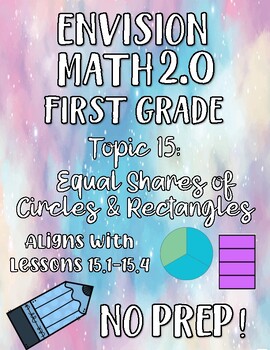First Grade enVision Math 2.0 Topic 15 No Prep Print And Go
- PDF
Description
This bundle aligns with first grade enVision math 2.0 program! Included in this bundle are 8 pages of work from topic 15 lessons 15.1 to 15.4- NO PREP! Print and GO! There are 2 supplemental sheets that aligns with each lesson in this topic!
DETAILS INCLUDED:
15.1: 2 sheets where students (sheet 1) write the number of equal shares in each shape and (sheet 2) draw lines to show the equal shares in a circle, rectangle and square then write the number of equal shares.
15.2: 2 sheets where students (sheet 1) color the shapes for each problem based on the given directions. Students are either color one half or one fourth/quarter for each set of shapes.(sheet 2) Students solve word problems and explain their comprehension supporting whether or not the word problem is correct or incorrect and why.
15.3: 2 sheets where students (sheet 1) color the shapes that show halves red and color the shapes that show fourths blue then write the total number of equal shares for each shape. (sheet 2) students draw lines in the given shapes (circle, square, rectangle) to divide the shapes into halves, quarters, or fourths.
15.4: 2 sheets where students draw a picture to solve each word problem then complete the sentence to make it true.
These worksheets can be used for homework, classroom (independent work or math centers), test prep, extra practice and more!





